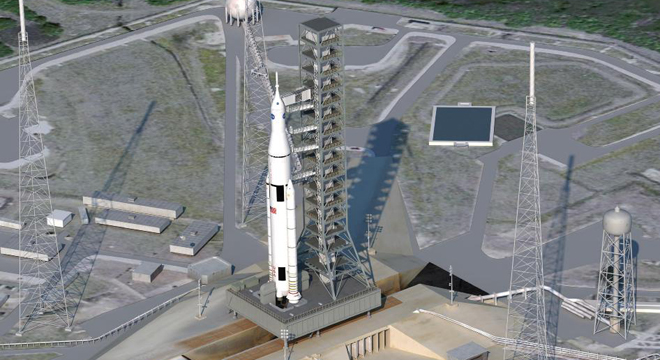It’s not your grandfather’s space shuttle.
The design for NASA’s new Space Launch System (SLS), unveiled Wednesday morning, is touted as the vehicle that will allow astronauts to visit “near-Earth asteroids, Mars and its moons and beyond.” It’ll serve as a go-between for the International Space Station as well. Watch a video simulation below and find out more from NASA here.
“This launch system will create good-paying American jobs, ensure continued U.S. leadership in space, and inspire millions around the world,” NASA Administrator Charles Bolden said in a a statement. “President Obama challenged us to be bold and dream big, and that’s exactly what we are doing at NASA. While I was proud to fly on the space shuttle, kids today can now dream of one day walking on Mars.”
But the proposed over 30 story tall, deep space, heavy-lift spacecraft does recycle a number of parts from the old Space Shuttle, which was retired in July this year.
Specifically the Space Launch System will recycle five of the RS-25D/E engines from the shuttle program for its core, or bottom rocket booster stage, which will be a “stretched version of the shuttle’s bullet-shaped external tank,” USA Today reports.
In contrast to the Space Shuttle, which used solid rocket boosters to get it off the launchpad, the new Space Launch System will rely on a “liquid hydrogen and liquid oxygen propulsion system,” and NASA is holding a competition for private aerospace companies to win the contract to develop this system.
The upper stage will rely on the new J2-X engine, which had initially been developed for a separate space shuttle replacement program, Constellation, scrapped by President Obama back in February 2010.
In a press conference on Wednesday, NASA associate administrator for human exploration operations William Gerstenmaier adamantly refuted the idea that the new vehicle was a retread. “It’s not fair to say that this is a rocket built from shuttle parts,” he said, “The components are being used in new novel ways.”
Both re-purposing efforts are thanks to the President and Congress, which in January ordered NASA to reuse the old and partially-developed equipment to cut down on costs. In April, Congress passed NASA’s 2011 budget at $18.5 billion under such conditions.
The SLS is estimated to cost a total $30 billion over the next 10 years for two initial test flights: It’s slated to fly unmanned in 2017 and then again in 2021 with a crew. That comes to $3 billion a year, with development beginning last week on the Orion Multi-Purpose Crew Vehicle, which will carry the astronauts on the SLS rocket.
The final design was selected after a “months-long, comprehensive review of potential designs, to ensure that the nation gets the best possible rocket for the investment,” said Bolden in a video statement.
The main question is whether or not NASA will actually be able to keep to roughly those cost levels. The agency has a long history of incurring delays and cost overruns, to which lawmakers have become increasingly less sympathetic in the current fiscal climate of crisis.
As the Orlando Sentinel soberly reminded readers in the midst of the unveiling hubbub: “Congress is intent on cutting the federal budget and Obama has asked agencies to submit 2013 budget requests that are 10 percent below their 2011 levels — essentially a $1.85 billion cut to NASA.”
NASA had previously said that it wouldn’t be able meet lawmakers demands with current funding levels and sketched out a scenario that would speed up development of its deep space programs to the tune of $62.5 billion.
At the same time, the agency continues to fund private companies hoping to develop low-orbit craft to fill the vacuum left in the wake of the Space Shuttle’s retirement. The first of these, Space X’s unmanned Dragon, is due to dock with the space station in November.
Meanwhile, in the short term, the Russian Soyuz spacecraft remains the only means of transporting NASA astronauts into space, although it was briefly suspended from use following an Aug. 24 crash and only recently greenlighted to begin launches again starting Oct. 30.
Watch the video simulation NASA prepared of the SLS launch here (caution: loud):






